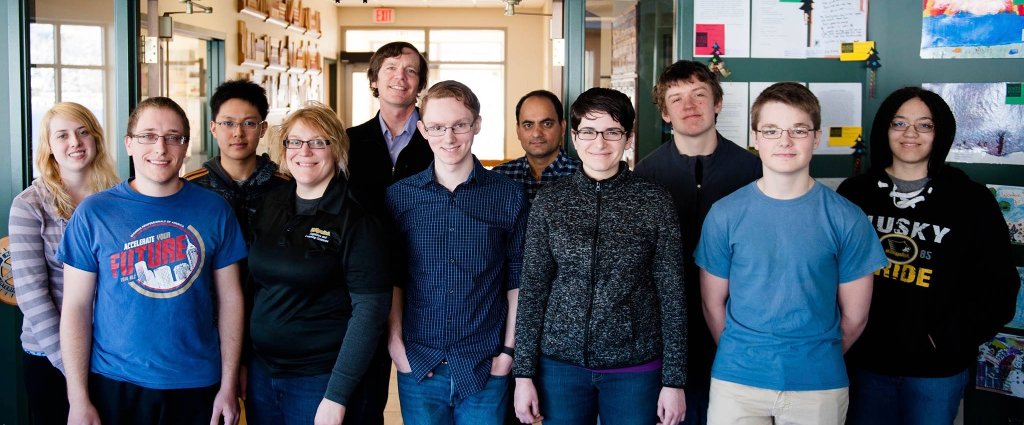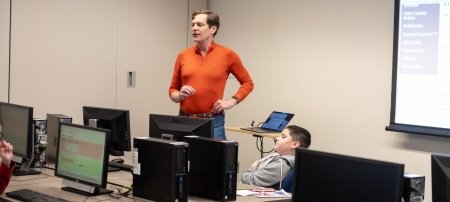Everyone needs a good teacher—including teachers. Providing support for teacher education shifts how participants chat in digital classrooms.
Even if online forums could talk, there would still be a lot of reading between the lines. So much of human communication is nonverbal, but in online classrooms, text and forums are the primary mode of communicating. Since interaction between classmates is a key part of learning, examining the patterns of communication in forums reveals a lot about the quality of a digital environment.
In a paper published in the Journal of Technology and Teacher Education, STEM education researcher Joshua Ellis shows how empowering teachers in online professional development classes can deepen their learning. The effects can then carry over into their own classrooms.
"My background is in designing online learning environments, and we know that you always want to design for the outcome—but we don't always know how to design for the outcome," says Ellis, who is an assistant professor in the Department of Cognitive and Learning Sciences at Michigan Technological University. "The study spurred conversations for us as designers because, at the end of the day, we have to ask, would we do this again?"
Communication Networks
In the study Ellis led, he supported 34 early-career teachers in an online induction program for two years. In education, induction programs provide support and guidance to novice teachers in their very first years of teaching. Programs such as these can help new teachers who are feeling isolated and far from learning opportunities.
The induction course helped participants feel more connected, but Ellis and the other organizers felt the comments and feedback between participants were too cursory and they wanted to help teachers dig deeper into constructive changes in their classrooms. More importantly, they wanted to help teachers help each other.
So, in the second year, the organizers decided to implement several teacher leadership techniques. These are ways for teachers to start seeing themselves as not simply a talking head in a classroom, but also as a mentor, coach, networker and observer. Ellis and his team had the teachers take on specific roles during group discussions—all done in online forums—playing everyone from a reflective participant, a practitioner, a scholar and a supportive colleague.
The team noted the comments delved into specific and constructive suggestions. Something else changed, too; the patterns of communication changed shape.

"The conversation got less organic when everyone started taking on roles," Ellis says, adding that the shape changed from a "messy map" with lots of interactions between all the participants. "It got into a hub and spoke arrangement instead, which at first I thought it might be a negative side effect, but what it really shows is a more centralized, targeted conversation."
Alongside the diagrams, the team ran qualitative analyses of the content of the conversations and they used a rubric to determine how reflective, technical and pedagogical the forum comments were.
Communication patterns and leadership techniques are not only for supporting teachers. They can have a bigger impact on digital classrooms in general.
Digital Literacy
During the last decade, online classes have expanded across the whole nation. That trend is slowing down, but many universities are still coming online. At Michigan Tech, online course sections have increased from 45 in 2007 to 283 in 2017. Tom Freeman, a senior instructional designer in the Center for Teaching and Learning at Michigan Tech, says online learning increases access to education but it comes with challenges as well.
"Online instructors have no choice: they have to know precisely what they're going to teach and how they're going to do that online well in advance, and they have to have it all built and ready to go before the students ever show up," Freeman says, adding that face-to-face learning can go with the flow more and be adapted right in the classroom.
The biggest perceived hurdle is digital literacy. Navigating an online course platform like Canvas, Moodle or Blackboard is not always intuitive. The Center for Teaching and Learning helps faculty—many of whom never received formal teaching education—adapt their courses. Freeman and Ellis, along with the center’s Jeff Toorongian, developed a new course for faculty called "Foundations of Teaching Online" to help instructors apply the principles of instructional design to create high quality, engaging, and effective online courses.
"The needs change and the design must change in order to meet people where they are," Ellis says. "One size does not fit all."
Ellis adds that online spaces are more egalitarian learning spaces; they tend to be more successful when the lecture-and-listen model is left behind and instructors cede some authority to their students. This can help students see online platforms as not just a repository for class notes and the mechanism for turning in assignments, but as an actual learning space where they study, ask questions, talk through examples and modify the process to best fit their own way of soaking up of knowledge.
Blended Environments
Most students will switch back and forth between online and in-person courses, and the latter will often have a digital component. These are what Ellis calls "blended environments" and he says they offer an opportunity to improve how people communicate and interact within different learning spaces.
The key is designing an intentional classroom, even if it's not a physical one. Through induction, teachers can learn to be leaders and students can learn to be teachers. For Ellis, the first step is looking at how people communicate online and how that exchange mirrors changes in the classroom environment.
Michigan Technological University is an R1 public research university founded in 1885 in Houghton, and is home to nearly 7,500 students from more than 60 countries around the world. Consistently ranked among the best universities in the country for return on investment, Michigan's flagship technological university offers more than 120 undergraduate and graduate degree programs in science and technology, engineering, computing, forestry, business, health professions, humanities, mathematics, social sciences, and the arts. The rural campus is situated just miles from Lake Superior in Michigan's Upper Peninsula, offering year-round opportunities for outdoor adventure.







Comments